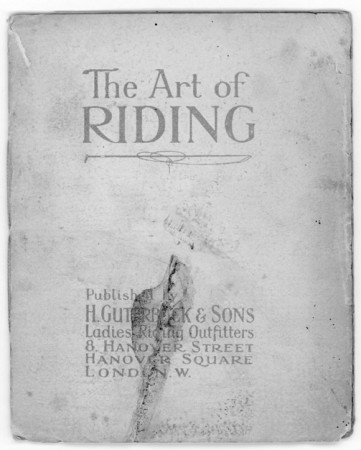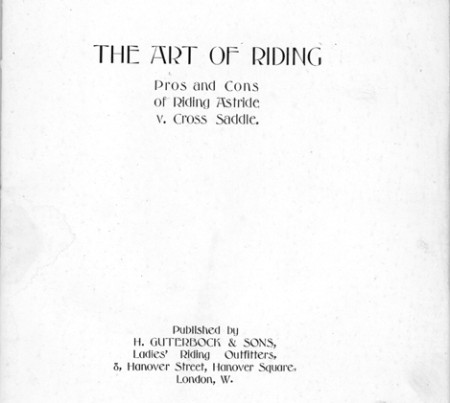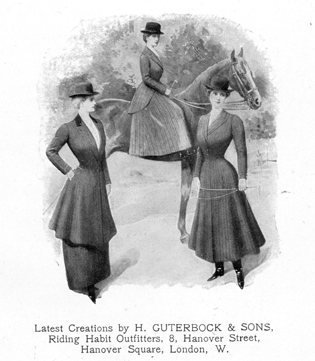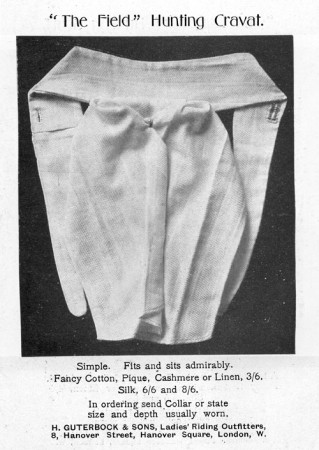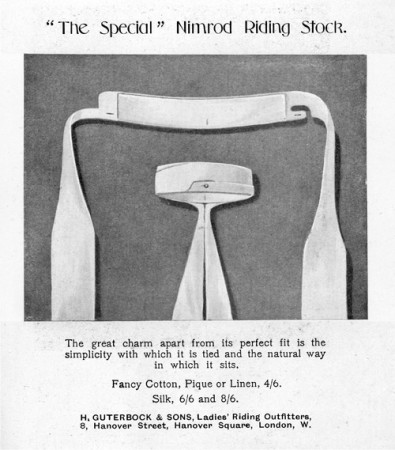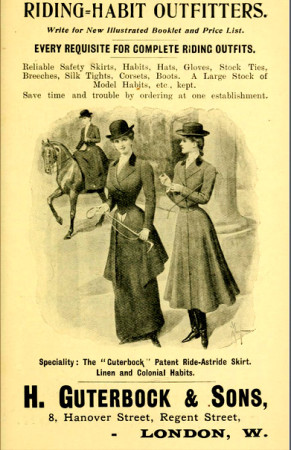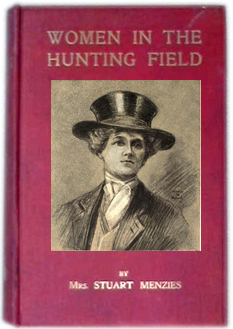The Art of Riding
comad August 26th, 2014
We have been unable to contact the publisher so if you are a representative of Guterbock & Sons, please accept this acknowledgement. There is no publishing date but it is likely to have been circa 1908.
The Art of Riding by Lilian E. Bland
Preface.
The following article from the able pen of so renowned an exponent of the art of riding as Miss Lilian Bland, will command the attention and secure the interest of all horse-women; and we are much mistaken if her enthusiastic testimony to the advantages and added pleasure of the Cross Saddle, does not induce many who have not yet done so to try this method of riding. Such a method is altogether impracticable without a specially designed habit.
Realising this led us, some years ago, to give our serious attention to devising the most suitable form of garment for cross saddle riding, and if we may judge by the warm eulogies passed by our clients on our efforts in this direction, we may safely conclude that we have succeeded admirably.
We have a little booklet illustrating our designs of Ride-Astride Garments, Coats, Skirts, Breeches, &c., which we will forward with pleasure to any lady who is sufficiently interested to send us her name and address.
Pros and Cons of Riding Astride versus Side Saddle
by Lilian E. Bland.
There have been many discussions lately on the subject of women riding astride, and the public in general seem to regard the matter as something new and startling – as the latest fad of the up to-date woman, which, according to their various ideas, is either shocking or ridiculous. Why? Simply because in England they are not accustomed to see ladies riding astride, and the Britisher has always ridiculed any novelty; afterwards, when the “novelty” has become the fashion, they forget that they abused the pioneers of the movement, and will say that they always considered it the best and most sensible method.
From an historical point of view the side saddle is a fairly modern invention, and was, I believe, first used, by Queen Anne, the consort of Richard I of England, and the ladies who adopted it were mounted on the off side. Many women, however, still preferred to ride astride, and up to the latter part of the 18th century ladies thus mounted attended the hunts, or rode for pleasure and sport with their falcons on their wrists. Riding in those days, owing to the bad roads which were often merely rough tracks through the forests, was the easiest mode of travelling; still we find that it was only in the 19th century (perhaps because side saddles were then greatly improved), that ladies no longer rode cross-legged, and when a few years ago some ladies who had the courage of their opinions adopted the old and sensible method, and turned out in divided skirts with the Devon and Somerset stag-hounds, they were looked at askance, and the more conventional regarded them with disfavour.
Fortunately ours is an age of emancipation; old fashioned conventions are slowly giving way to common sense. The modern Englishwoman travels far afield, she shares the sports and dangers of her brothers or husband, she sees many nations and different customs. Women in the Colonies, in America, India, Africa, Australia, ride astride as a matter of course; often they must spend hours in the saddle over rough country, or in mountainous and hilly districts along narrow and dangerous paths, where a side saddle would only be an additional danger to the rider. But leaving danger out of the question, a side saddle would never be a good fit for the various breeds of ponies and country bred horses, while the additional weight would tell heavily in a long journey, and a side saddle would be weariness to horse and rider; so the English woman sensibly adopts the custom of the country, and returns home with a broader view of life in general.
Mrs. Alec Tweedie, in her delightful book on Mexico, (“Mexico as I saw it” – pub. 1901) tells us that women all ride astride there – it never occurs to them to adopt any other method; the Europeans follow suit, and fully realize the advantages and comfort of a man’s saddle.
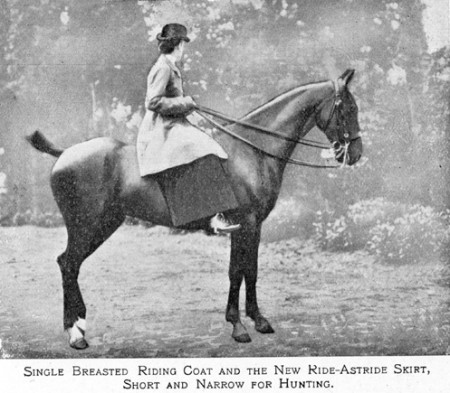
That the movement has not spread more rapidly in England is no doubt partly due to the influence that the fashion of the day and convention have on the feminine mind. Women have not as a rule the courage of their convictions, especially when it comes to offending. “Mrs. Grundy” – that evil minded goddess of their own creation. Many also object to it from the aesthetic point of view; they imagine they would not look as well as they do in a side saddle. This, of course, is merely a matter of choosing a suitable form of coat and skirt, or coat and breeches; there are models for every make of figure to choose from, and, of course, they should also be suitably mounted. Naturally slight well-made figures always look best, but, on the other hand, a stout woman would ride considerably lighter in a man’s saddle.
Many leaders of Society are showing their appreciation in the most feasible way, and have adopted a man’s saddle on various occasions; to mention a few well known names – The Duchess of Westminster, Lady Castlereagh and Lady Chelsea, all look extremely well in the saddle.
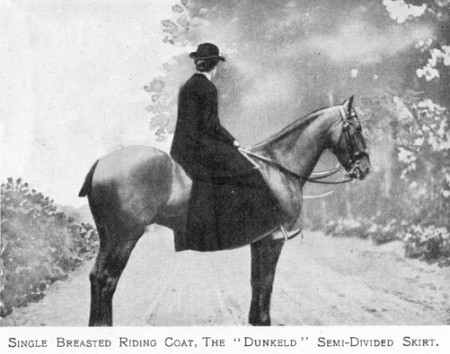
There can be nothing unseemly to criticise if a lady is properly turned out and can ride well. Most children now are taught first to ride cross-legged, and certainly as long as they are growing they should not ride in a side saddle for any length of time. The modern side saddle, with its straight seat and broad crutches, an immense improvement on the old type of saddle, is still far from perfection when compared to a man’s saddle, with its easy fit to horse and rider, while the abuse of the side saddle leads in many cases to curvature of the spine, crooked shoulders, back aches, etc.; and it has been the cause of many serious and fatal accidents from ladies getting their habits caught on the crutches, or their foot dragged in the stirrup. These accidents are of course less liable to happen with the modern safety habit and patent stirrup, but that they can still happen I know from personal experience.
THE DISADVANTAGES of the SIDE SADDLE.
Side saddles have many disadvantages – the most serious one from the rider’s point of view is the difficulty of getting out of the saddle at a critical moment, when perhaps one’s life depends on falling clear of the horse. For instance, when a horse rears badly, or making a mistake at a fence comes over backwards, then a lady is in a most helpless position, and must trust to luck that she will be able to throw herself clear of the saddle. A man in the same circumstances can generally slip his feet out of the stirrups, and slide off backwards or sideways. Another strong point against ladies’ saddles is that grooms as a rule do not pay enough attention to the fit of the saddle to the horse’s back.
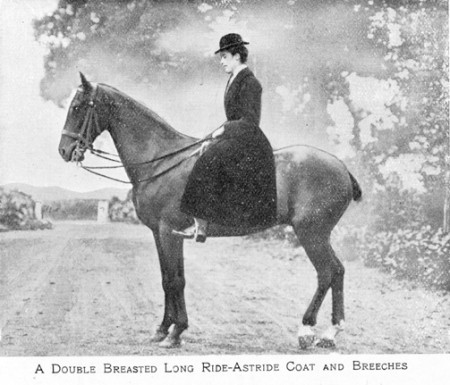
WEIGHT
The average weight of a saddle is from 18 to 22 lbs (8 to 10 kg) while the girths, stirrups, numnah, etc., will add another 3 or 4 lbs., which is nearly double the weight of a man’s hunting saddle which averages from 10 to 12 lbs (4.5 to 5.5 kg) Taking the weight of a side saddle and accessories at 24 lbs (11 kg), and a hunting saddle at 13 lbs (6 kg), a lady has the extra dead weight of 11 lbs., a severe handicap to start with; and a woman of 10 to 12 stone (63 to 76 kg) naturally requires a heavier build of saddle than a light weight, and weight tells considerably, especially on a long days’ hunting. Side saddles are much hotter to the horse’s back, and even with good riders the weight is more on the near side, the horse has to be girthed tighter, thus confining the free action of the lungs and heart. If the saddle does not fit properly (leaving the withers and backbone free) and the rider is an indifferent horsewoman, the saddle may, and probably will, do serious damage to the horse. I have seen horses laid up for months, the effect in some cases of an hour under a bad rider; some horses literally have their backs cut out of them, others have their withers wrung, and a common result of rising in the stirrup is a lump raised by the drag of the saddle on the off side of the wither; this lump, often quite small, sometimes develops into a “fistulous” wither, which may take months to heal, and in some cases the horse has to be destroyed. Occasionally they are permanently lamed by injuries to the spine, and it is small wonder that men are chary of lending a good horse to a “side saddle.”
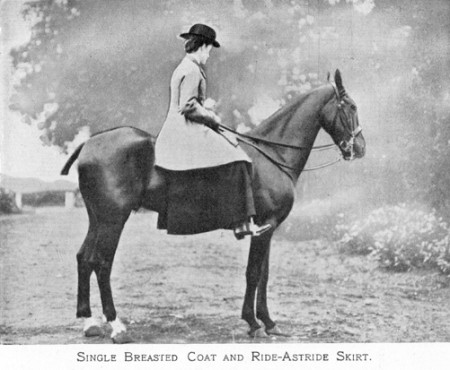
The rider’s position in a side saddle is both cramped and unnatural. To sit straight with the shoulders square to the horse’s ears, one must twist the spine crooked from the hips, and one can never get a really straight pull at the horse. Riding constantly one gets hardened to the discomforts of the saddle, but at first the under part of the right knee generally gets cut where it has to grip the crutch. Most hunting women have now adopted the hunting jog, which means sitting easy in the saddle without rising to the horse’s action, and which is far less tiring to horse and rider, if (and this is a large “ IF ”) the horse is a good hack, with smooth easy action. Unfortunately a good hunter is often a rough hack, and one’s life in the saddle, especially after a long and tiring day, is pure misery. The only way to avoid being shaken to pieces is to have your side saddle made narrow enough to allow the use of an extra stirrup on the off side, then one can ride home astride and in comfort, rising easily to the horse’s action, and the change of position is a wonderful rest to legs that have been cramped for several hours.
There are several saddlers of high repute who make a saddle of this description, which is quite comfortable to ride astride on, the usual ridge on the off side having been cut down where the right leg goes over.
Another disadvantage of the side saddle is the difficulty of mounting without assistance, and a lady will often sit in the saddle when she might rest her horse by dismounting, rather than have the bother of getting a ” leg-up ” to mount again; while a man is constantly able to rest himself and his horse by dismounting, and it is a great relief to a hunter to have the weight out of the saddle even for a few minutes – in this way also a man can save his horse up a steep hill by running beside him. A lady is always at a disadvantage in opening gates, where a man can use his legs to bring the horse up close to the gate and prevent him from swerving away. Expense is a serious consideration to many. The price of a side saddle varies from 11 pounds 11 shillings (£11.55) to 16 pounds, and there are many extras, such as patent stirrups, doeskin pommels, linen lining to saddle, numnahs, girths, etc., which items easily mount to another four guineas (£4.20). To strike an average, one might allow 18 pounds 18 shillings (£18.90) for a side saddle, complete with bridle, etc. The average price of a gentleman’s hunting saddle is 6 pounds 6 shillings (£6.30), with accessories say 9 pounds 9 shillings (£9.45) – a considerable saving of expense compared to the 18 pounds 18 shillings of a lady’s outfit!
Thus a man saves a good deal in money and weight, and he can also ride several pounds lighter than a woman of the same weight can in a side saddle.
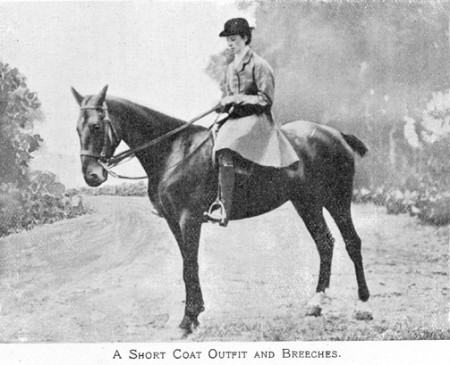
This saving of weight is also economical where the horse is concerned – a woman if she rides astride may count on saving 12 or 14 lbs.(5 to 6 kg) in weight. A well-bred weight carrier is an expensive item, the price of course varying considerably; still one could not get a good weight carrier under £100, and of course three or four hundred is constantly given for them in the shires. Women as a rule are much lighter than the average hunting man, and good light-weight hunters are not hard to find, and may cost anything from £20 to £100.
In a side saddle one certainly has a firmer seat, but at the same time one has not the same control as a man has with horses that refuse or swerve badly at the fences. Horses, with few exceptions swerve to the left. The reason of this is that most people ride with the whip in the right hand; a man can keep the horse straight by using his legs.
I can only think of one disadvantage to ladies riding astride, and that with practice would vanish also; they have not such a firm seat as in the side saddle, where the crutches make it almost impossible to be thrown. Riding is a matter of balance and grip, the balance comes naturally, the grip comes with practice which strengthens the muscles of the thighs and legs; but most of the time one rides by balance; it is only jumping, or when a horse shies, stumbles, etc., that one really grips, and then ones legs close instinctively on the horse to steady oneself in the saddle, and the grip is more from the knee and calf of the leg than from the thigh. Now as to the choice of a saddle, everyone is the best judge of what suits them; but I think the easiest saddle for ladies to ride astride on is one with a curved seat, the head of the tree cut back and a round cantle, while the flaps could have knee rolls. I give an illustration of a saddle with special knee rolls, which gives one a very firm seat; this saddle is used by a well-known dealer for backing refractory horses – the knee roll can of course be made smaller.
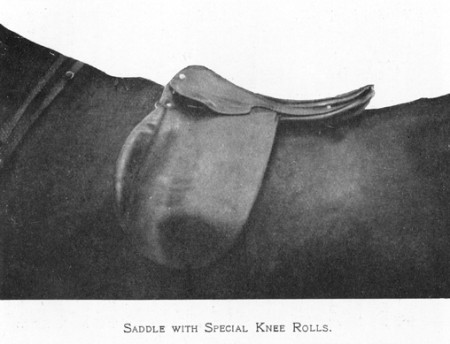
There are some good patents for stirrup leathers, which prevent any possibility of being dragged by the stirrup. One of the best is a saddle fitted with Passmore’s bars, with a fairly heavy stirrup iron; another good one is Weston’s safety bar; but the majority do not use any patent, simply riding with plain leathers and heavy irons.
The length at which to ride that is considered correct is the measurement from the tips of the fingers to the armpit, but it is better to ride too short than too long. One can learn much from watching a good rider; one’s seat in the saddle should be upright without being stiff, the leg from the knee downwards should be practically without motion; nothing looks worse than to see a man swinging his leg like a pendulum to the action of the horse; one’s feet should be parallel to the horse’s side, it looks ugly to see people riding with the toes of their boots turned outwards, and the feet should rest well home in the stirrups.
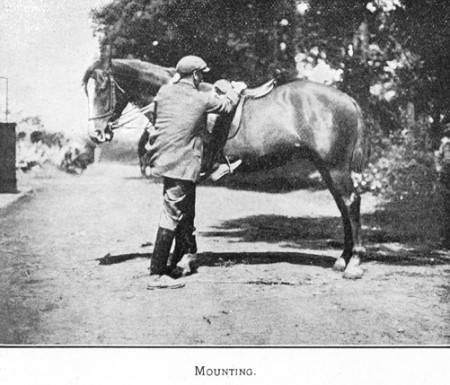
Ladies must remember, when mounting without assistance, always to have the near rein shorter, so that the horse’s head is turned towards them; many horses will not, or rather have not been properly trained to stand still when they are mounted, especially in the hunting field, where they are keen to be off. If a horse’s body is curved towards one, it is always easy to mount, and if he swirls round it will be in the right direction to throw you into the saddle, and not out of it, which would be the case if his head were free to turn from you.
I don’t think a lady, or for the matter of that a man either, should wear spurs, in the first place because not one person in a hundred knows how to use them, and secondly there is a certain amount of danger of their catching in the stirrup iron, if one is thrown.
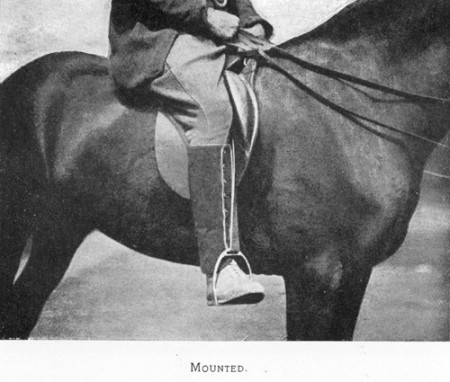
Ladies should ride thoroughbred horses, when their weight and means permit it; their make and shape is more suitable. A broad thick set horse would probably be very tiring to most women. There is no more delightful sensation than the long easy stride of a thoroughbred under one, when one can sit down in the saddle and enjoy a good gallop, and feel the splendid freedom of movement in the horse, and one’s own freedom to enjoy it, without being perched up on a side saddle, which always makes one feel separated from the horse, and not in harmony with its every motion. The rider must learn to use her legs properly, to make the horse change his legs, turn and twist correctly on his hind legs, and also to make him take off at the fences with his hocks well under him.
To turn a horse to the right the rider presses with her left leg behind the girths, and vice versa, and all horses should be taught to obey the pressure of the rein on the neck. It would be better perhaps for ladies to learn jumping in a riding school as it does not matter then if the horse gets away from them. When the horse is rising at the fence the rider should lean forward slightly, and sit well back in the saddle when landing, and above all things, learn to keep her hands low and not hold on by the reins; there is an old saying and a very true one, that “more horses are thrown by the bridle than by the fences,” so that the first thing to acquire is a firm seat in the saddle. Beginners will find that it is a great help to hold on by the martingale or breastplate and leave the reins quite loose or have them fastened to the head stall, then they cannot damage the horse’s mouth. Men when they are thrown fall as a rule on their heads or shoulders, which is a method not to be recommended.
Falling should be part of a rider’s education, and one should learn to fall on one’s feet: or, where this is impossible, to break fall scientifically with the least jar to one’s system. Ladies who have already learnt the Japanese game of Ju-Jitsu, in which the first lessons are in the art of falling will no doubt be able to apply this method to riding, which would be both practical and useful, for the best riders must occasionally leave the saddle unintentionally.
Whether riding astride will ever become the custom in the hunting field one must leave for the future to decide, and certainly unless ladies rode really well, it would be a mistake to attempt hunting as they would only make themselves ridiculous by falling off, and getting in everyone’s way; indeed the same remark might be applied to many of the opposite sex, who think when they have bought a good hunter and a scarlet coat, that they can hunt, but then as no one is expected to stop and pick them up it does not matter so much, whereas no one likes to see a lady in difficulties.
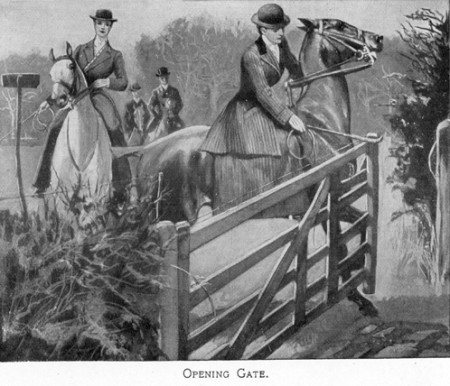
But once ladies realise the ease and comfort of riding astride, it will make riding for pleasure or exercise even more popular than it is already. If they wear a divided skirt they can ride over to a friend’s house for lunch or tea, and feel as cool and neat as they would in an ordinary walking skirt; while bridle paths, and rides across country in summer, will have an additional charm. Gates that have been too heavy or difficult to open need no longer stop us, for it is easy to dismount and get on again. There is no exercise so delightful as a country ride in summer, either in the freshness of the early morning or in the cool of the evening, and a good horse is the most sympathetic and unselfish friend we have.
Now as to the correct outfit for riding astride, there are various models to suit every style of figure, and loose or semi-fitting coats look best. Ladies who object to showing their legs and feet can wear divided skirts, while a slim well-made woman will look neat and workmanlike in a long coat and breeches, with gaiters and boots; if the coat only comes down to the knee, gaiters should always be worn in preference to top boots, as owing to the shape of a woman’s leg, top boots never seem to fit properly below the knee, and it is when the leg is pressed against the saddle that the fault is most noticeable – there is generally a gap showing between the boot and the back of the leg. When women wear divided skirts the onlooker would not realise that they were riding astride except perhaps by the easy, straight and more graceful seat that can only be attained in a man’s saddle.
At Messrs. Guterbock & Sons, of Hanover Street, the pioneers of the Cross Saddle Habit, are shown a number of the latest models for riding astride. The firm is famous for its specialities in riding “kit” for ladies, and for many years have studied the question of a suitable outfit for ladies riding astride, with the result that their models are both practical and smart, while the cut and style is irreproachable. Every sportswoman will find it well worth her while to inspect the various outfits for herself; it would fill many pages to give a detailed description of them all, and I find it easier to describe a horse than a habit! But for the benefit of those who cannot pay a visit to 8, Hanover Street themselves I must mention a few models that struck me as being perfect in design.
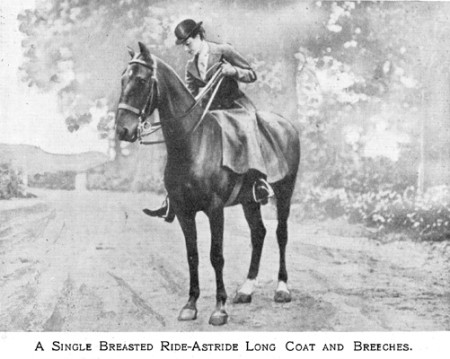
Broadly speaking, there are two types of “kit” – one consists of breeches and a long or short coat, and the other is a divided skirt worn over breeches, and a coat of any style that one may choose.
The breeches are either laced or buttoned at the knee – the latter are neater and are made with seamless knees and seats.
“The Cottesmore” pattern have a most ingenious fastening at the knee, which would no doubt be a comfort to many riders, as they stretch should the leg become swollen. Of the long coats, No. 44, a single-breasted coat, hung in perfect lines in the saddle and looked very neat.
No. 46, a double-breasted coat with a waist seam and belt looked both ‘smart’ and comfortable., and would be a charming model for riding in the country. No. 88 is a short coat to be worn with breeches, leggings and boots, and admirably adapted for slight well-made figures.
Most of the divided skirts (see illustrated Booklet) can be used equally well for walking or climbing, and when the rider is on foot no one could tell the difference from an ordinary walking skirt. ” The Dunkeld,” No. 84, is a favourite model with Messrs. Guterbock’s customers. Dismounted, the fronts button across, and it becomes a neat and smart walking skirt; in the saddle, the front panel buttons back to allow the skirt to divide. One skirt designed for the hunting field was most workmanlike; cut considerably shorter, with narrow skirts, the flaps being strapped with leather, and the bottom edge being faced with durable rubber inside .
Many people still think that riding astride will never really “come in,” but Messrs. Guterbock realise that it has already “come in” and come to stay. Demands for ride astride outfits are rapidly increasing, and orders flow in daily, not only from the Colonies and abroad, but from the up-to-date sportswomen at home, and the firm certainly deserves the world-wide success they have won.
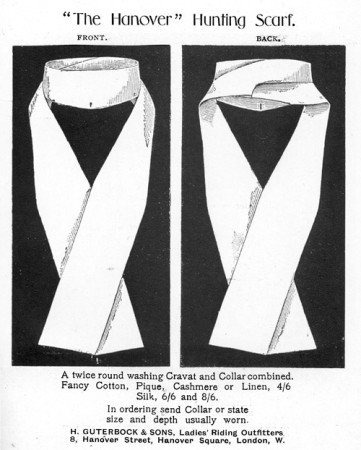
Advertisement from ‘A Hunting Catechism’
by Col. R.F. Meysey-Thompson – 1907
(I have included the following article which gives a flavour of hunting in Ireland at that time. ed)
“HUNTING FOR THE HARD UP”
by Amy Charlotte Stuart Menzies
Vinton & Co. – London – 1913
Chapter 14 page 252
We are not all rich – in fact, some of us are very much the reverse – but that is no reason why you should not hunt. On the contrary, hunt all the more, to drown dull care and blow away the cobwebs. Do not attempt to hunt in a swagger country with a swagger pack. If you are poor, go to Ireland, where, in many parts, people are not expected to turn out very smart. You can, if it so pleases you, tie your saddles and bridles on with string, keep your horse undipped, and enjoy yourself none the less; while potatoes being cheap, you can both live on them, which means you will both grow fat inside and lean outside. But what matter ?
There is a great charm in doing everything for yourself. I know a girl who gets rather more than her share of fun out of life. She is gifted with a keen sense of humour, and does everything for herself. What more perfect combination could you have? She generally has two horses in her stable, which she grooms, clips, feeds, and hunts. To this stud she has now added a motor car, which she drives, cleans, and overhauls herself, with the help of a small boy at two and sixpence a week, who washes it, under the eye of the mistress. There is pleasure in grooming your horse and looking after him. You know then he is not neglected. A one-horse woman has of necessity to consider the length of her day. She cannot hunt four days a week and stay out all day; but people will often mount a woman who can ride and show off a horse that they wish to sell, which fills in between the two days she allows herself on her own horse. I have met women who ride to sell, and very successfully they do it. There is no doubt a woman who is a light weight, and has good hands, can show off a horse to advantage. Those blessed with these qualities seldom lack a mount; everybody is ready to lend them a horse.
There are also many provincial packs in England where most excellent sport is shown without any great expenditure or splash; but Ireland is the place.
I love Hibernian blarney! How much nicer it is to be told you are the ‘glory of the sunshine,’ ‘a beautiful pearl,’ and all the rest of it, even though you know the flatterer will within an hour call you a scarecrow, a kill-joy, and so on! What he says behind your back won’t hurt you, only what he says to your face; you must take it with a grain of salt, and feel happy and amused. The astounding ‘tarra diddles’they will tell you, looking you straight in the face with blue eyes of truth and earnestness, are worth going to Ireland for; and the happy-go-lucky way of living – it is all a revelation.
Some friends of mine, being in low water, thought they would go and hunt in Ireland. Seeing a place advertised sounding very cheap, they wrote to the advertiser, a Dublin agent, who sent a most flowing description of the place. Off they went to see it, to find the beautiful old castle, as it was called, in a hopeless state of neglect; the front gates consisted of the top and bottom of an old iron bedstead tied together with string. Being unable to master the Irish knots, they climbed this and went on up to the house, which was of great size. After a long fight with the key, they managed to effect an entrance.
In what had once been a drawing-room there were piles of chickens’ and ducks’ feathers, where they had evidently been plucked for market, otherwise surely there could never have been so many. In the old banqueting hall horses had evidently been stabled. Upstairs owls were making their homes.
An old man, who answered to a gardener, came to interview them, so my friend began asking about the shooting. Were there many snipe? “Ah shure, and if his worship would only go down to the shore in the marning, he would find them in their thousands! ” I do not know whether it was this that decided my friends to take the place, but they spent two very happy years there, and hunted to their hearts’ content on an astonishingly small amount of money; but they did not play at being English, they went to Ireland and did as the Irish do.
Nobody ever comes back from Ireland without being in love with the country and the people.

- Comments(0)
